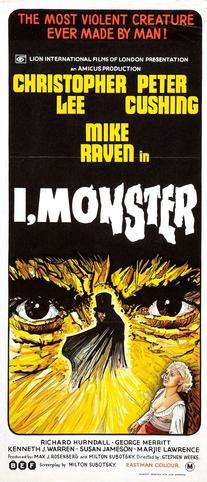I, Monster
I, Monster is a 1971 British horror film directed by Stephen Weeks (his feature debut) for Amicus Productions. It is an adaptation of Robert Louis Stevenson's 1886 novella Strange Case of Dr. Jekyll and Mr. Hyde, with the main characters' names changed to Dr. Charles Marlowe and Mr. Edward Blake.[1]
| I, Monster | |
|---|---|
 Theatrical release poster | |
| Directed by | Stephen Weeks |
| Produced by | John Dark Max Rosenberg Milton Subotsky |
| Written by | Milton Subotsky |
| Based on | Strange Case of Dr. Jekyll and Mr. Hyde by Robert Louis Stevenson |
| Starring | Christopher Lee Peter Cushing Mike Raven Richard Hurndall George Merritt Kenneth J. Warren |
| Music by | Carl Davis |
| Cinematography | Moray Grant |
| Edited by | Peter Tanner |
| Distributed by | British Lion Films (U.K.) The Cannon Group (U.S.) |
Release date |
|
Running time | 75 minutes |
| Country | United Kingdom |
| Language | English |
Plot
Psychologist Charles Marlowe (Lee) invents a drug which will release his patients' inhibitions. When he tests it on himself, he becomes the evil Edward Blake, who descends into crime and eventually murder. Utterson (Cushing), Marlowe's lawyer, believes that Blake is blackmailing his friend until he discovers the truth.
Cast
- Christopher Lee – Dr. Charles Marlowe / Mr. Edward Blake
- Peter Cushing – Frederick Utterson
- Mike Raven – Enfield
- Richard Hurndall – Dr. Hastie Lanyon
- George Merritt – Mr. Poole
- Kenneth J. Warren – Mr. Deane
- Susan Jameson – Diane Thomas
- Marjie Lawrence – Annie
- Aimée Delamain – Landlady
- Michael Des Barres – Boy in Alley
- Lesley Judd – Woman in Alley (uncredited)
- Ian McCulloch – Man at Bar (uncredited)
Production
It stars Christopher Lee as the doctor and his alter ego, and Peter Cushing as Frederick Utterson, a central character in Stevenson's original story. Mike Raven and Susan Jameson also star. It was photographed by Moray Grant, with music by Carl Davis.[2]
Peter Duffell, who had previously worked for Amicus, was offered the movie to direct, but turned it down.[1] Financing came from British Lion and the NFFC.[3]
It was intended to be shown in 3-D utilizing the Pulfrich effect, but the idea was abandoned upon release.[4]
Reception
The film performed poorly at the box office.[3] Time has been kinder to the film and it is now seen as a very faithful adaptation[5] with Drew Hunt of Chicago Reader listing it as one of Christopher Lee's five best roles.[6]
References
- Hallenbeck 2015, p. 112.
- Miller & Johnson 2009, p. 226.
- Bryce 2000, p. 72-79.
- Hallenbeck 2015, p. 112-115.
- Hallenbeck 2015, p. 115.
- Hunt 2015.
Sources
- Bryce, Allen (2000), Amicus: The Studio That Dripped Blood, Stray Cat Publishing Ltd, ISBN 978-0953326136
- Hallenbeck, Bruce G. (2015), The Amicus Anthology, Midnight Marquee Press, ISBN 978-1936168569
- Hunt, Drew (14 June 2015), Christopher Lee's five best performances, Chicago Reader, retrieved 22 February 2017
- Miller, Mark A.; Johnson, Tom (2009), The Christopher Lee Filmography: All Theatrical Releases, 1948-2003, McFarland & Company, ISBN 978-0786446919